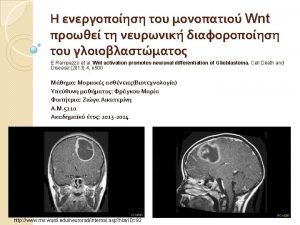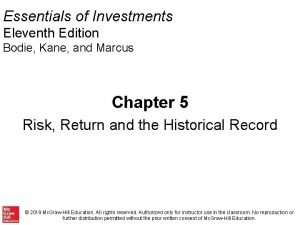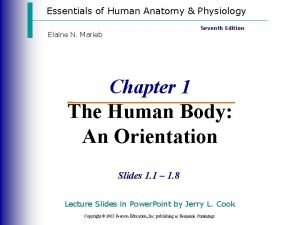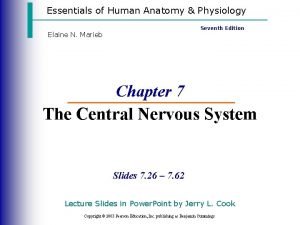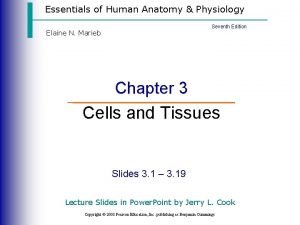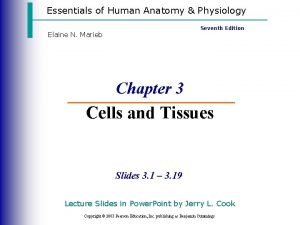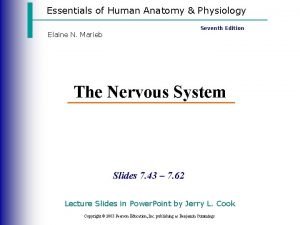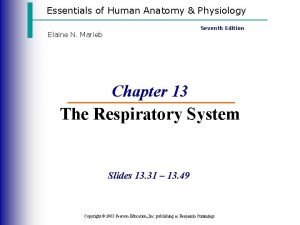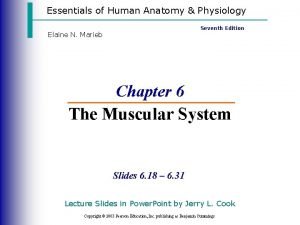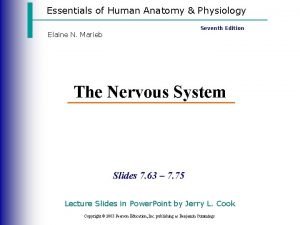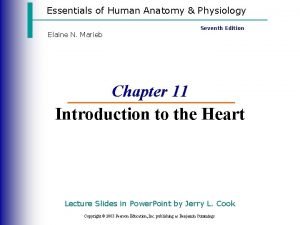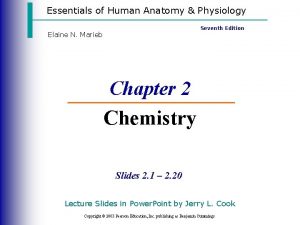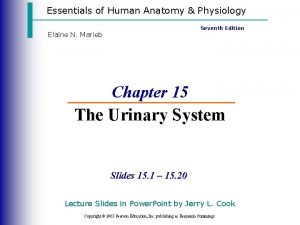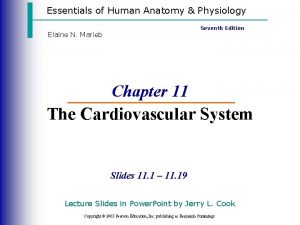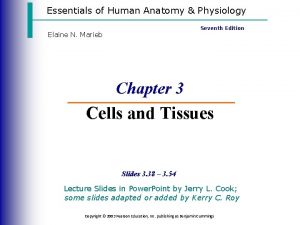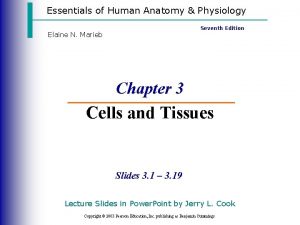Essentials of Human Anatomy Physiology Seventh Edition Elaine

















- Slides: 17

Essentials of Human Anatomy & Physiology Seventh Edition Elaine N. Marieb Chapter 3 Cells and Tissues Slides 3. 38 – 3. 54 Lecture Slides in Power. Point by Jerry L. Cook Copyright © 2003 Pearson Education, Inc. publishing as Benjamin Cummings

Body Tissues Cells are specialized for particular functions Tissues Groups of cells with similar structure and function Four primary types Epithelium Connective tissue Nervous tissue Muscle Copyright © 2003 Pearson Education, Inc. publishing as Benjamin Cummings Slide 3. 41

Epithelial Tissues Found in different areas Body coverings and linings Glandular tissue Functions Protection (Ex. Skin) Absorption (ex. In Digestive tract) Filtration (ex. In kidneys) Secretion (glands) Copyright © 2003 Pearson Education, Inc. publishing as Benjamin Cummings Slide 3. 42

Epithelium Characteristics Cells fit closely together Tissue layer always has one free surface The lower surface is bound by a basement membrane Avascular (have no blood supply) Regenerate easily if well nourished Copyright © 2003 Pearson Education, Inc. publishing as Benjamin Cummings Slide 3. 43

Classification of Epithelium Classification is based on 1) # of Cell Layers Then 2) Shape of Cell

Classification of Epithelium Number of cell layers Simple – one layer Stratified – more than one layer Figure 3. 16 a Copyright © 2003 Pearson Education, Inc. publishing as Benjamin Cummings Slide 3. 44 a

Classification of Epithelium Shape of cells Squamous – flattened Cuboidal – cube-shaped Columnar – column-like Figure 3. 16 b Copyright © 2003 Pearson Education, Inc. publishing as Benjamin Cummings Slide 3. 44 b

Simple Epithelium Simple squamous Single layer of flat cells Usually forms membranes Lines body cavities Lines lungs and capillaries Copyright © 2003 Pearson Education, Inc. publishing as Benjamin Cummings Figure 3. 17 a Slide 3. 45

Simple Epithelium Simple cuboidal Single layer of cube-like cells Common in glands and their ducts Forms walls of kidney tubules Covers the ovaries Copyright © 2003 Pearson Education, Inc. publishing as Benjamin Cummings Figure 3. 17 b Slide 3. 46

Simple Epithelium Simple columnar Single layer of tall cells Often includes goblet cells, which produce mucus digestive tract lining Figure 3. 17 c Copyright © 2003 Pearson Education, Inc. publishing as Benjamin Cummings Slide 3. 47

Simple Epithelium Pseudostratified Single layer, but some cells are shorter than others Often looks like a double cell layer Sometimes ciliated, such as in the respiratory tract May function in absorption or secretion Copyright © 2003 Pearson Education, Inc. publishing as Benjamin Cummings Figure 3. 17 d Slide 3. 48

Stratified Epithelium Stratified squamous Cells at the free edge (exposed part) are flattened (Ex. Surface of skin) Found as a protective covering where friction is common Locations Skin (contain keratin for extra durability) Mouth Esophagus Copyright © 2003 Pearson Education, Inc. publishing as Benjamin Cummings Figure 3. 17 e Slide 3. 49

Stratified Epithelium Stratified cuboidal and columnar Rare in human body Found mainly in ducts of large glands NOT ON Test Copyright © 2003 Pearson Education, Inc. publishing as Benjamin Cummings Slide 3. 50

Stratified Epithelium Transitional epithelium Shape of cells depends on amount of stretching Lines organs of the urinary system Bladder, Ureters, etc Figure 3. 17 f Copyright © 2003 Pearson Education, Inc. publishing as Benjamin Cummings Slide 3. 51

Glandular Epithelium Gland – one or more secretion cells (Secretion product varies) Two major gland types Endocrine gland Secretes Hormones Ductless Exocrine gland Empty through ducts to the epithelial surface Include sweat and oil glands Copyright © 2003 Pearson Education, Inc. publishing as Benjamin Cummings Slide 3. 52

Connective Tissue Found everywhere in the body Includes the most abundant and widely distributed tissues Functions Binds body tissues together Supports the body Provides protection Copyright © 2003 Pearson Education, Inc. publishing as Benjamin Cummings Slide 3. 53

Connective Tissue Characteristics Variations in blood supply Some tissue types are well vascularized Some =poor blood supply (ex. Tendons/ ligaments) or are avascular (ex. Cartilage) Extracellular matrix Non-living material that surrounds living cells Copyright © 2003 Pearson Education, Inc. publishing as Benjamin Cummings Slide 3. 54
 3 layers of muscle
3 layers of muscle Uterus perimetrium
Uterus perimetrium Anatomy and physiology ninth edition
Anatomy and physiology ninth edition Chapter 1 introduction to human anatomy and physiology
Chapter 1 introduction to human anatomy and physiology Holes essential of human anatomy and physiology
Holes essential of human anatomy and physiology Medial and lateral
Medial and lateral Chapter 2 human reproductive anatomy and physiology
Chapter 2 human reproductive anatomy and physiology Chords rule in dbms
Chords rule in dbms Principle of information system
Principle of information system Molecular biology of the cell seventh edition
Molecular biology of the cell seventh edition Biology seventh edition
Biology seventh edition Human anatomy fifth edition
Human anatomy fifth edition Human anatomy fifth edition
Human anatomy fifth edition Network security essentials 5th edition pdf
Network security essentials 5th edition pdf Business essentials 12th edition
Business essentials 12th edition Essentials of investments 11th edition
Essentials of investments 11th edition Business essentials 12th edition answer key
Business essentials 12th edition answer key Essentials of sociology 5th edition
Essentials of sociology 5th edition









